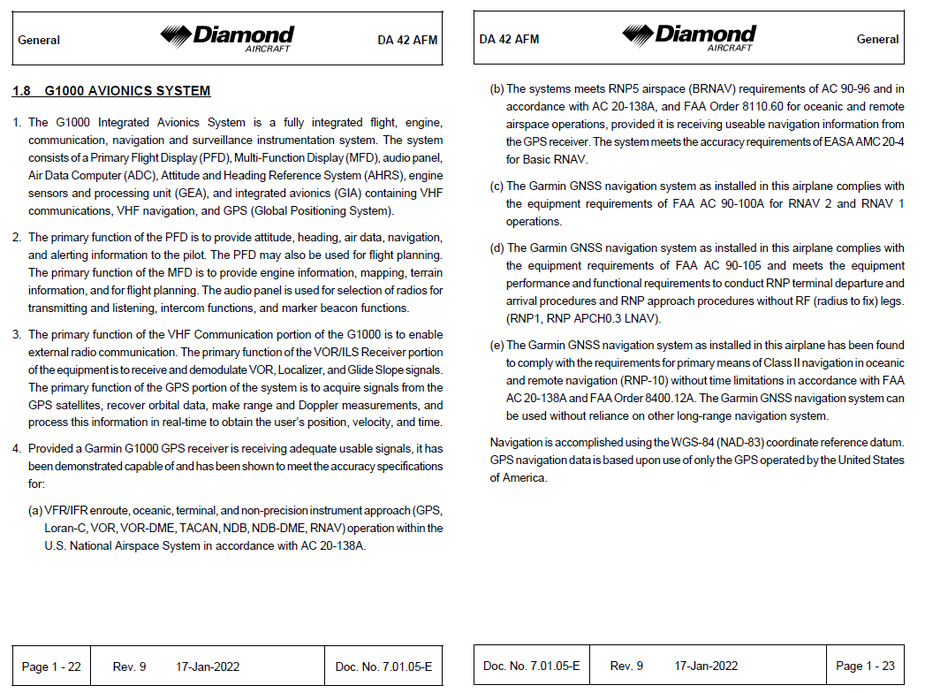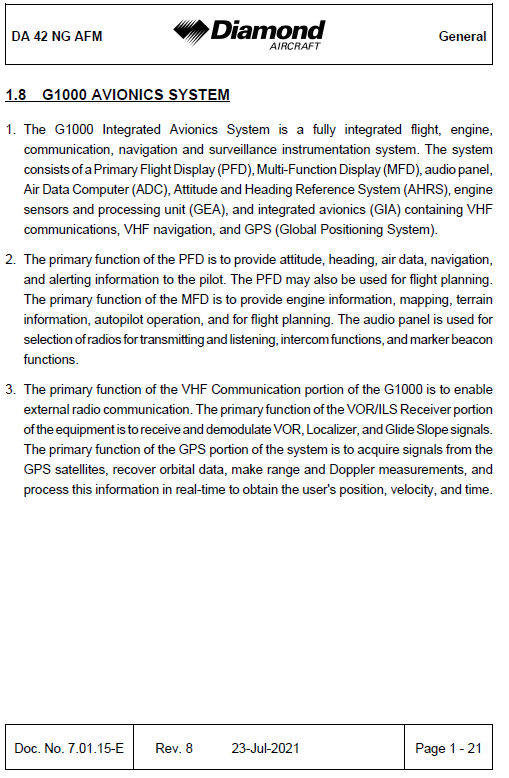NCYankee wrote:
Under US regulations, updates to the AFMS is not required unless an AD is issued that dictates the document to be updated.
This is not the case under EASA. Even if it was compliant under AC 90-100 it needs to be stated in the AFM or supplement that it is. Also, revision 8 was released in 2021 so it’s no excuse for it to be missing from the AFM… nor would it make sense to say it was the case that they left it out because the aircraft is TC was issued prior to 2012 since the TDI manual contains the required statements.
Airborne_Again wrote:
Yes, but according to Cttime there are no such references in the AFMS. References in the G1000 pilot guide does not help as they can only refer to the capabilities of the equipment, not of the installation.
Many valid AFMS predate the 2012 PBN designations. That is why in the US, the AC 90-100 Compliance document was generated. Under US regulations, updates to the AFMS is not required unless an AD is issued that dictates the document to be updated.
References in the G1000 pilot guide does not help as they can only refer to the capabilities of the equipment, not of the installation.
Exactly. And actual G1000 capabilities depend on LRUs installed in specific aircraft.
NCYankee wrote:
References should also be found in the G1000 pilot guide and in the AFMS.
Yes, but according to Cttime there are no such references in the AFMS. References in the G1000 pilot guide does not help as they can only refer to the capabilities of the equipment, not of the installation.
It doesn’t need to have the reference. AC 90-100A refers to a reference document that will handle most of it for a G1000 system. References should also be found in the G1000 pilot guide and in the AFMS.
NCYankee wrote:
There are many legacy systems that don’t provide PBN ICAO compliance, but do comply. In FAA land, this is covered by a compliance table referred to in AC 90-100A. The AFMS you posted shows what the system compliance is. So based on the AFMS, I would code the following in an ICAO flight plan:
The issue is not with the DA42 POH but with the DA42NG POH which does not have a reference to any FAA AC’s. (At least not on the pages that Cttime has shown.)
There are many legacy systems that don’t provide PBN ICAO compliance, but do comply. In FAA land, this is covered by a compliance table referred to in AC 90-100A. The AFMS you posted shows what the system compliance is. So based on the AFMS, I would code the following in an ICAO flight plan:
ICAO Equipment: S, G, R
ICAO Surveillance: S
ICAO PBN: B2, C2, D2, S1
B2 because of compliance with AC 20-138A and AC 90-96
C2 and D2 because of compliance with AC 90-100A and the compliance table where it refers to the G1000 and the compliance with AC 90-105
S1 because of its compliance with AC 90-105. I would not code A1 for RNAV 10 even though the AFMS says it can because at least in the US, the compliance with either A1 or L1 requires a Letter of Agreement from the FAA.
It does not comply with SBAS.
Cttime wrote:
I’ve contacted Diamond several times and they either don’t understand the problem as I’ve laid it out or don’t care to pass the information on to someone who does.
They just don’t care. Their primary (and probably only) goal is to sell as many as possible aircrafts to flight schools. And they are only concerned if the complaints come from these fleets.
I’m reviving this old thread because it seems Diamond still doesn’t care about providing owners/operators with information on the correct PBN specifications for the G1000.
Let me explain:
As I alluded to in my original post from 5 years ago, an aircraft may use a certain PBN specification when the STC or TC holder provides a statement of compliance with the applicable specification(s). Well, I discovered during this year that the latest revision of the DA42 NG AFM has no such statement (I don’t remember seeing this in previous revisions either). To be clear it says nothing about what PBN specifications the G1000 is compliant with (disregarding that we know generally what is able to perform). Part NCO.IDE.A.195 (d) requires for PBN operations that “the aircraft shall meet the airworthiness certification requirements for the appropriate navigation specification.” The GM1 last out the ways in which this can be demonstrated (see my original post).
For contrast see the DA42 TDI (non-sbas) AFM

There we clearly see what PBN specifications and FAA/EASA standards it complies with.
If we look in the same section of the NG AFM, there are no such statements:

Note that some NG have SBAS in which the A33 supplement applies and provides a clear statement (non-SBAS lack any similar supplement).
All of this means (to me) that a pilot of a 42 NG without SBAS cannot comply with NCO.IDE.A.195 (d) because you can’t show what specifications are complied with. I’ve contacted Diamond several times and they either don’t understand the problem as I’ve laid it out or don’t care to pass the information on to someone who does.
In the US, without PBN D1, D2 or D4, one will not get an RNAV SID or RNAV STAR. Also the FAA validates the sensors, so if you use D1, you need to have D, G, I, R all specified in field 10A. Approach capability is not validated, so PBN codes of S1 or S2, T1, or T2 are not relevant nor is B in 10A. There are only a very few SIDs that require PBN O2 as these RNAV SIDs that have RF turns require RNP 1 instead of RNAV 1 using GPS. Z in 10A requires that there be an 18 entry in COM/, DAT/, or NAV/ or the flight plan will not pass validation. I see no use for NAV/SBAS being enforced or used in the US. US also has a PBN override in the NAV/ entry of the form NAV/RNVDnEnAn where n is 0 (No RNAV), 1 (RNAV 1) or 2 (RNAV 2) for and D is departure (SID), A is Arrival (STAR), and E is enroute RNAV route. To override PBN codes, either specify A0 to not accept RNAV STAR and D0 to not accept RNAV SID. If you don’t specify the An or Dn, that is treated the same as A0 or D0. So PBN/D2 NAV/A1 would permit assignment of RNAV STARs but not RNAV SIDs.
Edit: FAA also does not care about field 10b transponder type other than to indicate if it has altitude encoding or not. So C is as good as E or L. Also FAA asks that CODE/ be included for aircraft with ADS-B Out and that if the ADS-B Out is 2020 compliant, to include SUR/260B or 282B or both as appropriate.